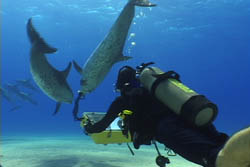
by Hardy Jones
Humpback eye phto by Gene Flipsy
Two things may doom Japanese whaling, at least in the Antarctic.
The Japanese whaling fleet has just departed for its annual Antarctic whale
hunt but the enterprise operated by the Institute of Cetacean Research for the
Japan Fisheries Agency faces two huge problems at home:
a chronic lack of demand for for whale meat and possible UN regulations barring the antiquated Japanese whaling fleet from entering Antarctic waters.
More than 5-thousand tons of whale meat has been freezered from last year's hunt due to declining demand for the product. According to the Sydney Morning Herald (The Australian) the whaling business requires a subsidy of nearly ten million dollars per year to maintain operations.
A parliamentary waste-cutting panel, convened by the new government, has recommended the whaling business's main source of funding, the Overseas Fisheries Co-operation Fund, be shut down. This would end whaling in the Antarctic and possibly all factory ship whaling.
In addition, United Nations regulations mandate certain hull specifications for vessels entering Antarctic waters. The Nissin Maru, the factory ship on which Antarctic whaling depends, does not meet those standards and may be prohibited from entering the fragile Antarctic ecosystem.
Fate moves in strange ways. As we fight whaling and dolphin slaughter we cannot predict which methods will be effective. It may be that either of the two factors cited above will provide the Japanese government with a face saving way to end this barbarous business. What a wonderful day that would be.



